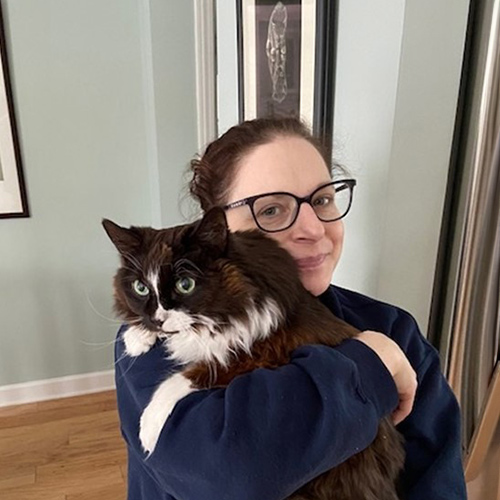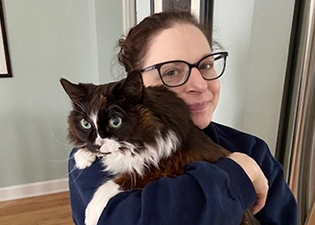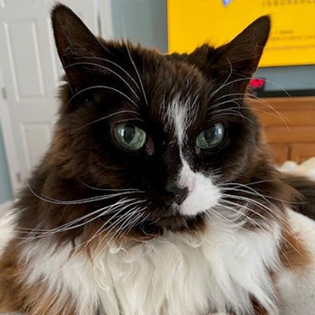
Gretchen and Amy: An inseparable pair who share chronic illness and lots of love
The heartwarming tale of a cat's healing power, a groundbreaking treatment, and the unbreakable bond with her owner.
This audio recording was enabled by AI
Some say cats can sense when something is wrong. Just ask Gretchen Schafer, a Michigan woman, who often spends her days in bed with a warm, purring cat named Amy who brings her comfort and company.

But when Amy got sick several years ago and could no longer jump on the bed or onto Gretchen’s lap, the Schafer family worried that Amy’s life was nearing the end.
That’s when they learned about Solensia® (frunevetmab injection), and the story took a surprising turn.
‘Cat lovers’ fall in love
Gretchen and Bill Schafer married 20 years ago. They met through a dating app and connected instantly. “Bill didn’t see me as a weird cat lady. He was a weird cat guy, too,” said Gretchen. “We are still both cat lovers. We now have four. They are part of our family.”
About two years into their marriage, Gretchen and Bill visited a shelter to adopt a kitten. That’s when they met a 6-month-old feline that Gretchen knew was “the one” as soon as she held her close.
“I named her Amy after a 1970s Pure Prairie League song. It was a song I’d loved since I was a kid and would dance around to it in the kitchen and sing it at the top of my lungs in the car.”
A best buddy and ‘bush dweller’
Amy fit right in with the Schafer family, and her “sweet” and distinct personality delighted them. “Our other three cats are climbers and jumpers,” said Gretchen. “But Amy is more of a bush dweller. She likes hiding under things, which has made for some interesting ‘where’s Amy’ moments.”

But Amy’s favorite thing is to be on Gretchen’s lap… or snuggled next to her on the bed… or under her feet in the bathroom. “Anywhere I am, Amy is there too. She makes it clear to everyone that I’m hers and she’s mine.”
The bond between the two became even stronger about 10 years ago as Gretchen’s illness advanced. “I have connective tissue disease, and there are times when I can barely get out of bed. I think Amy can sense when I’m getting worse,” said Gretchen. “When I’m having a really bad day, I’ve got this warm body next to me – or on me – who is just purring and loving me and doesn’t want anything. It calms me and reminds me I’m here to take care of her, too.”
‘She’s not quite herself’
About four years ago, Gretchen and Bill noticed a shift in Amy. “She was not quite herself,” said Bill. “She was definitely not moving around as much and struggled to jump on the bed to be with Gretchen. You could tell she was hurting.”
Bill placed pet-size stairs around the house so Amy could stay close to Gretchen. “At first, we thought she was getting old, but then we knew we needed to get her to the vet,” said Bill.
There was just one problem: COVID-19. “Where we live, many veterinarians closed their doors, and others were overwhelmed during the pandemic,” said Gretchen. “Amy started getting worse, and we were afraid we would have to put her down. We were frantically trying to find a vet to help us.”
A diagnosis and a spark of hope
Ultimately, the Schafers connected with Dr. Michelle Meyer, a Michigan veterinarian, who examined, tested and x-rayed Amy to figure out why the cat was declining quickly. The x-rays showed that Amy had osteoarthritis and some other issues. “When I saw the x-rays, I was shocked that Amy could move at all,” said Gretchen.

Dr. Meyer started Amy on a routine of weekly ketamine injections and cold laser treatments, which continue to this day, and told the Schafers about a Zoetis clinical trial for Solensia, the first and only once-monthly monoclonal antibody for the control of osteoarthritis pain in cats. The veterinarian helped the Schafers get Amy enrolled in the clinical trial, and the results overwhelmed Gretchen and Bill.
“Within two days of her first dose – I kid you not – the results were amazing,” said Gretchen. “We went from grieving about the possibility of having to put Amy down to, wow, this is a new cat.”
‘The cat whisperer’
Amy continues to do well on Solensia and her other treatments and has reclaimed her rightful place with Gretchen. At 18 years old, Amy also has kidney disease. Because Solensia functions like a naturally occurring antibody, it is eliminated with minimal involvement from the liver and kidneys1 – a critical factor, considering the prevalence of kidney disease in older cats like Amy.
“Bill is in charge of administering Amy’s other medicines. He’s the cat whisperer,” said Gretchen. “He adores Amy, and I love watching them together.”
Gretchen has many fond memories of Amy. “I can see her racing up and down the hall with a silly wiggle when she was very young. And I love all the memories of her being elderly and just chilling with me for hours.”
There’s one experience that stands out the most, and it took place when Gretchen was quite ill. “I was throwing up over the side of the bed. I rolled over, and Amy was right there next to me. It was as if the light shone in the room. Her being there and purring at me turned my mood right then. It’s hard to explain what pets can do emotionally and physically in these moments. But it’s easy to explain that Amy is family.”
Published on March 4, 2024
References
1 Keizer RJ, Huitema AD, Schellens JH, Beijnen JH. Clinical pharmacokinetics of therapeutic monoclonal antibodies. Clinical Pharmacokinet. 2010; 49(8):493-507.
IMPORTANT SAFETY INFORMATION: For use in cats only. Women who are pregnant, trying to conceive or breastfeeding should take extreme care to avoid self-injection. Allergic reactions, including anaphylaxis, could potentially occur with self-injection. SOLENSIA should not be used in breeding cats or in pregnant or lactating queens. SOLENSIA should not be administered to cats with a known allergy to frunevetmab. The most common adverse events reported in a clinical study were vomiting and injection site pain. See full Prescribing Information.
SLN-00508
Copyright © Zoetis Services LLC 2013-2024 All rights reserved. The product information provided in this site is intended only for residents of the United States. The products discussed herein may have different product labeling in different countries.